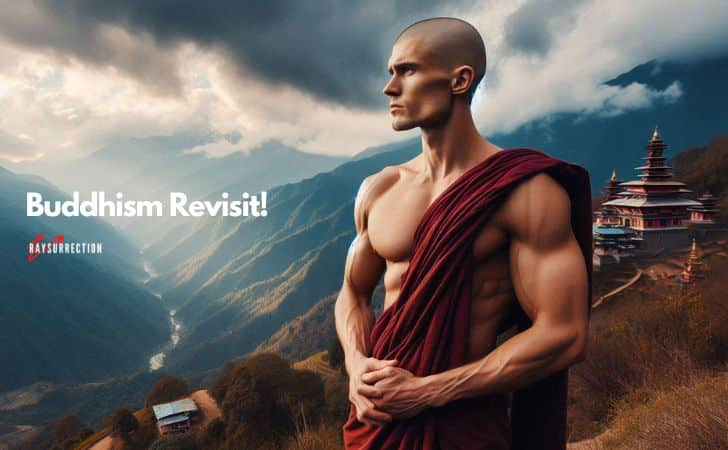Okay. Today, let’s take a stroll through the different schools of Buddhism. This isn’t going to be a stuffy lecture or anything like that. Instead, let’s just chat about these traditions in simple terms, keeping it light and easy to follow. If you’ve been curious about Buddhism but found the terminology intimidating, this should help clear things up a bit.
What Is Buddhism All About?
Before jumping into the schools, let’s take a moment to talk about what Buddhism actually teaches. Buddhism is based on the teachings of Siddhartha Gautama, known as the Buddha. He lived around 2,500 years ago in India and spent his life seeking answers to some big questions. Why do people suffer? How can we find lasting peace and happiness? He eventually found a path, which we now call enlightenment, and spent the rest of his life sharing what he discovered.
At its core, Buddhism is about understanding the nature of life and finding a way to ease suffering. The Buddha taught what’s often called the Four Noble Truths:
- Suffering Exists: Life isn’t always easy. People face challenges like illness, loss, and stress.
- There Is a Cause of Suffering: This usually comes from craving or wanting things to be a certain way.
- Suffering Can End: It’s possible to stop this cycle of craving and dissatisfaction.
- There’s a Path to End Suffering: The Buddha laid out steps you can follow, often called the Eightfold Path. It includes practices like mindfulness, ethical living, and meditation.
Buddhism isn’t about worshiping a god or following strict dogma. It’s more like a guide to living a peaceful, meaningful life. It encourages people to observe their own thoughts and actions and to work toward being kind, wise, and aware.
A lot of people like Buddhism because it’s practical. You don’t have to believe anything without seeing how it works in your own life. You can try meditation, reflect on your actions, and see if these practices make a difference for you.
What Are the Schools of Buddhism?
Buddhism has evolved over centuries, and because of that, different branches have formed. Each one has its own way of practicing and interpreting Buddha’s teachings. These schools are often categorized into three main groups: Theravāda, Mahāyāna, and Vajrayāna. Let’s break these down one by one.
1. Theravāda Buddhism (སྟོང་གསུམ་པ་)
Theravāda means “The Teaching of the Elders.” Think of this as one of the oldest schools, sticking closely to what’s recorded in the early texts.
- Where you’ll find it: This tradition is popular in places like Sri Lanka, Thailand, Myanmar (Burma), Laos, and Cambodia.
- Main focus: This school emphasizes personal practice. People here focus on meditation and ethical living to eventually reach Nirvana—a state of being free from suffering and rebirth.
- How it’s practiced: If you’ve ever heard about monks in saffron robes or seen photos of people meditating in quiet forests, that’s often Theravāda. Monks and nuns play a big role, dedicating their lives to spiritual practice while others support them through donations.
Imagine having a roadmap, and you’re walking step by step with patience. That’s what Theravāda feels like—a steady, grounded way of walking toward enlightenment.
2. Mahāyāna Buddhism (ཐེག་ཆེན)
Mahāyāna translates to “The Great Vehicle.” This school’s perspective is more expansive, emphasizing helping others on their spiritual path.
- Where you’ll find it: It’s widespread in countries like China, Japan, Korea, Vietnam, and Taiwan.
- Main focus: While Theravāda focuses on individual enlightenment, Mahāyāna places more emphasis on compassion. The idea is to work toward enlightenment, not just for oneself but for everyone.
- How it’s practiced: In Mahāyāna, you’ll hear a lot about Bodhisattvas. These are people who’ve reached a high level of spiritual understanding but choose to stay in the world to help others instead of leaving the cycle of rebirth.
Think of this as traveling on a bus where everyone’s supporting each other. You’re not just looking at your own path but also helping others reach their destination.
3. Vajrayāna Buddhism (རྡོ་རྗེ་ཐེག་པ་)
Vajrayāna, also known as the “Diamond Vehicle,” is a branch of Mahāyāna but has its own unique flavor.
- Where you’ll find it: This tradition is most closely associated with Tibet, but it’s also practiced in Bhutan, Mongolia, and parts of Russia and India.
- Main focus: Vajrayāna is all about transformation. It uses rituals, mantras (repeated words or phrases), and meditation techniques to help practitioners reach enlightenment quickly.
- How it’s practiced: One hallmark of Vajrayāna is its reliance on teachers (called lamas) and symbolic practices. You’ve probably seen colorful prayer flags or heard chants if you’ve come across Tibetan Buddhism—that’s Vajrayāna in action.
Imagine having tools and techniques that speed up the process. Vajrayāna doesn’t necessarily skip steps, but it moves through them in a way that feels more intense.
Other Schools and Subgroups
While those three are the major groups, some schools stand out within them. Let’s touch on a few:
a) Zen Buddhism (from Mahāyāna)
Zen is all about simplicity and direct experience. It focuses on meditation and mindfulness in everyday life.
- Where you’ll find it: Mostly in Japan and some parts of the West.
- How it’s practiced: Meditation (zazen) is central, often done while sitting quietly. Zen koans—those puzzling questions like “What is the sound of one hand clapping?”—are also used to shake up conventional thinking.
If someone enjoys a no-frills approach, Zen would probably appeal to them.
b) Pure Land Buddhism (from Mahāyāna)
This school revolves around devotion to Amitābha Buddha, who is believed to preside over a pure realm where people can be reborn to continue their practice.
- Where you’ll find it: China, Japan, and Vietnam.
- How it’s practiced: Chanting the name of Amitābha Buddha and living ethically.
This path feels a bit like having a spiritual safety net. Instead of focusing purely on meditation, people trust in Amitābha’s compassion.
c) Nichiren Buddhism (from Mahāyāna)
Nichiren Buddhism emphasizes chanting and faith in the Lotus Sūtra (a key Mahāyāna text).
- Where you’ll find it: Japan and growing globally.
- How it’s practiced: Chanting “Nam-myoho-renge-kyo” and focusing on self-improvement and positive action.
d) Tibetan Buddhism (from Vajrayāna)
Tibetan Buddhism is deeply tied to Vajrayāna but also integrates local traditions.
- Where you’ll find it: Tibet, Nepal, Bhutan, and in exile communities worldwide.
- How it’s practiced: Rituals, prayer wheels, and deep meditation practices guided by lamas.
Japanese Schools of Buddhism
Japan has a rich Buddhist tradition, with several schools that have developed unique practices and teachings. Let’s highlight them:
a) Zen Buddhism(禅)
This focuses on meditation and direct insight. Practitioners often engage in seated meditation (zazen) and reflect on koans to gain clarity.
b) Pure Land Buddhism(浄土宗)
Centered around faith in Amitābha Buddha, practitioners chant his name as a way to ensure rebirth in the Pure Land.
c) Nichiren Buddhism(日蓮宗)
Focused on chanting “Nam-myoho-renge-kyo” and placing faith in the Lotus Sūtra, this school emphasizes inner strength and social harmony.
d) Shingon Buddhism(真言宗)
Shingon emphasizes esoteric teachings, with a focus on rituals, mantras, and mandalas.
e) Tendai Buddhism(天台宗)
Tendai aims to integrate various Buddhist teachings into a unified practice. It stresses meditation and study of the Lotus Sūtra.
f) Jōdo Shinshū (True Pure Land)(浄土真宗)
This branch of Pure Land Buddhism was founded by Shinran. It emphasizes reliance on Amitābha Buddha’s grace rather than personal effort.
How Do These Schools Connect?
All these schools share a common foundation in the teachings of Buddha. The differences often come from cultural influences, historical contexts, or the specific practices emphasized. If you're drawn to mindfulness, you’ll notice all these schools share those practices, even if they’re expressed differently.
For example, Theravāda’s straightforward meditation practices might appeal to someone who prefers structure, while Mahāyāna’s focus on compassion resonates with those who feel inspired by helping others. Vajrayāna might interest someone who enjoys ritual and symbolic practice.
Buddhism Revisited, Wrapped Up
Buddhism’s schools are like different paths up a mountain. Each one has its rhythm, its pace, and its tools for the climb. While they might seem different at first, they share the same destination. If someone has a preference for simplicity, or they like the idea of rituals, there’s probably a tradition that will feel just right.
Hopefully, this little chat has cleared up some of the mystery around these schools. You're never supposed to have to pick the "right" Buddhism school, but you'll find the right moment to choose what's right for you naturally at some point. Curious to dive deeper? Let me know—there’s so much more to explore!




